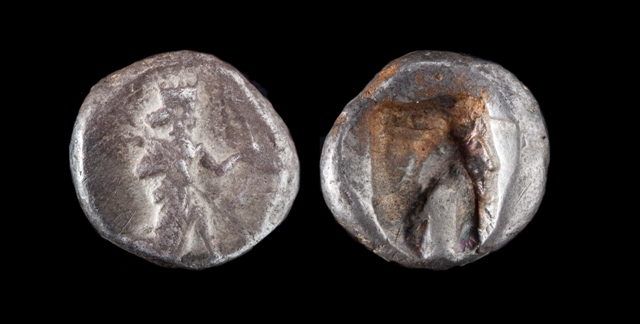Achaemenid, Silver Siglos
Dublin Core
Title
Achaemenid, Silver Siglos
Subject
Achaemenid (Persian) Empire. Silver Siglos, 485-470 BCE.
OBVERSE: Royal archer running right, quiver on back, holding bow in his left hand and a transverse spear in his right hand.
REVERSE: Oblong, tooth-shaped incuse mark.
OBVERSE: Royal archer running right, quiver on back, holding bow in his left hand and a transverse spear in his right hand.
REVERSE: Oblong, tooth-shaped incuse mark.
Description
This coin was minted during the time of one of the most famous attempts at Persian expansion, around the beginning of the fifth century BCE. The Battle of Marathon, where Darius I attempted to gain control of mainland Greece, is one of the most famous battles in all of Greek history. This battle was a turning point for Greek forces, which eventually won the battle to keep Persia at bay. Darius I died soon after the battle ended and his successor and son, Xerxes I, might have minted these coins to pay for foreign mercenaries in his own invasion of Greece in 481-479 BCE.
This motif of running royal figure was prominent during the whole of the Persian Empire. He is featured with a bow, quiver of arrows, lance, crown and a special garment without sleeves worn by archers. The coin also exhibits an early way of denoting running figures with the so-called Knielauf scheme, or a profile figure running with one knee bent. The figure has been interpreted as the great king Darius I, but is also referred to simply as a “royal figure.” These coins enjoyed a reputation of being made of high quality silver and were some of the best known coins in the ancient world. The Greeks referred to them as toxotai (archers).
This motif of running royal figure was prominent during the whole of the Persian Empire. He is featured with a bow, quiver of arrows, lance, crown and a special garment without sleeves worn by archers. The coin also exhibits an early way of denoting running figures with the so-called Knielauf scheme, or a profile figure running with one knee bent. The figure has been interpreted as the great king Darius I, but is also referred to simply as a “royal figure.” These coins enjoyed a reputation of being made of high quality silver and were some of the best known coins in the ancient world. The Greeks referred to them as toxotai (archers).
Source
Gift of James and Aneta McIntyre, Hallie Ford Museum of Art, Salem, OR. 2006.010.009
Date
ca. 485-470 BCE
Rights
Hallie Ford Museum of Art
Format
1.600 cm
5.300 gr
5.300 gr
Language
Persian
Type
Coin
Identifier
Darius I royal archer
Coverage
This item can be viewed on the Hallie Ford Museum of Art's website.
Citation
“Achaemenid, Silver Siglos,” Hallie Ford Museum of Art Exhibits, accessed January 5, 2026, https://library.willamette.edu/hfma/omeka/items/show/60.
